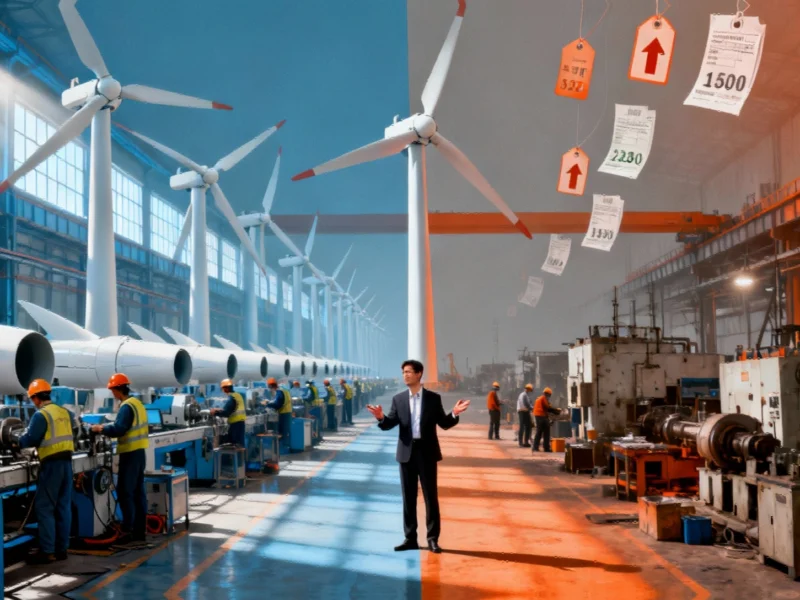Global Wind Power Economics at Crossroads
Western nations pursuing decarbonization goals face a critical cost-benefit analysis as they consider excluding Chinese wind technology from their energy transitions, according to industry leadership. Kai Wu, Goldwind’s vice-president for international operations, emphasized that rejecting China’s competitively priced turbines would inevitably translate to higher electricity costs for consumers, highlighting a fundamental tension between economic efficiency and supply chain sovereignty.
The Chinese wind turbine executive’s warning comes amid growing western scrutiny of clean energy imports, with the European Union launching subsidy investigations and the United Kingdom reviewing security implications of Chinese-manufactured technology. This industrial policy debate mirrors broader economic challenges, similar to how UK Chancellor Reeves acknowledges banking tax burdens while balancing fiscal and industrial objectives.
China’s Manufacturing Advantage and Western Responses
Wu revealed that China’s cost advantage in turbine manufacturing has grown to approximately 40% compared to western competitors, creating what he described as a “huge” differential that directly impacts project economics. “I always ask them: are you ready to sacrifice the cost of energy?” Wu stated during his Financial Times interview, pointing to the inevitable cost pass-through to electricity consumers when installation expenses increase.
This manufacturing efficiency stems from multiple factors, including state support, intense domestic competition, and technological breakthroughs that have driven down production costs. China’s clean energy investment reached $625 billion last year, nearly doubling since 2015, while Chinese companies now produce over 80% of global wind turbines, solar panels, and energy storage batteries.
Global Supply Chain Realities and Workforce Economics
The cost differential extends beyond manufacturing to human resources, with Wu noting that while some western engineering graduates command salaries approaching $140,000, the same investment could secure “at least three” comparable professionals in China. This labor cost advantage compounds China’s manufacturing edge, creating a comprehensive competitive package that western policymakers must confront.
Wu acknowledged the legitimacy of foreign governments wanting to strengthen local supply chains and create employment, calling these objectives “fully understandable.” However, he stressed that achieving energy affordability while building domestic manufacturing capacity presents a significant challenge, much like how AI in healthcare works best as a physician’s collaborator rather than replacement, requiring balanced integration of different capabilities.
Technological Leapfrogging and International Collaboration
China’s comparative late entry into renewable energy development provided opportunities for technological leapfrogging, according to Wu, who emphasized that the advantage isn’t about inherent superiority but timing and development trajectory. “We cannot say China is good and Europe is bad, or Europe is good, and China is bad. We have to see the ‘time’ difference,” he explained, advocating for more international wind industry collaboration.
Wu specifically highlighted areas where Chinese companies could learn from European expertise, including sophisticated financing models and technical standards for wind development. This collaborative approach reflects broader industry trends where technological leadership requires cross-border knowledge sharing, similar to debates about OpenAI’s ambitions to dominate artificial intelligence development and the balance between proprietary control and open innovation.
Market Projections and Emerging Challenges
Industry analysts at Wood Mackenzie forecast Chinese wind turbine manufacturers will dominate global markets over the next decade, projecting they will capture approximately 27% of installed capacity outside China, primarily in emerging markets. In Western markets, established players like Vestas, Siemens Gamesa, and Nordex are expected to maintain dominance, though potentially at higher cost structures.
Chinese manufacturers are increasingly focusing on offshore wind installations, which present greater technical challenges and higher costs but offer superior power generation potential. Wu identified project financing as “a real problem” during a recent Beijing forum with climate-vulnerable nations, noting that technological innovation alone cannot overcome infrastructure and construction cost barriers.
The industry faces complex decisions about technological sovereignty versus economic efficiency, reminiscent of content policy debates in other technology sectors, such as when OpenAI defends erotic content policy amid criticism, balancing different stakeholder expectations and regulatory environments. As Western nations navigate these competing priorities, the fundamental question remains whether consumers and policymakers are prepared to accept higher energy costs as the price for reduced dependence on Chinese clean technology.
Based on reporting by {‘uri’: ‘ft.com’, ‘dataType’: ‘news’, ‘title’: ‘Financial Times News’, ‘description’: ‘The best of FT journalism, including breaking news and insight.’, ‘location’: {‘type’: ‘place’, ‘geoNamesId’: ‘2643743’, ‘label’: {‘eng’: ‘London’}, ‘population’: 7556900, ‘lat’: 51.50853, ‘long’: -0.12574, ‘country’: {‘type’: ‘country’, ‘geoNamesId’: ‘2635167’, ‘label’: {‘eng’: ‘United Kingdom’}, ‘population’: 62348447, ‘lat’: 54.75844, ‘long’: -2.69531, ‘area’: 244820, ‘continent’: ‘Europe’}}, ‘locationValidated’: True, ‘ranking’: {‘importanceRank’: 50000, ‘alexaGlobalRank’: 1671, ‘alexaCountryRank’: 1139}}. This article aggregates information from publicly available sources. All trademarks and copyrights belong to their respective owners.



